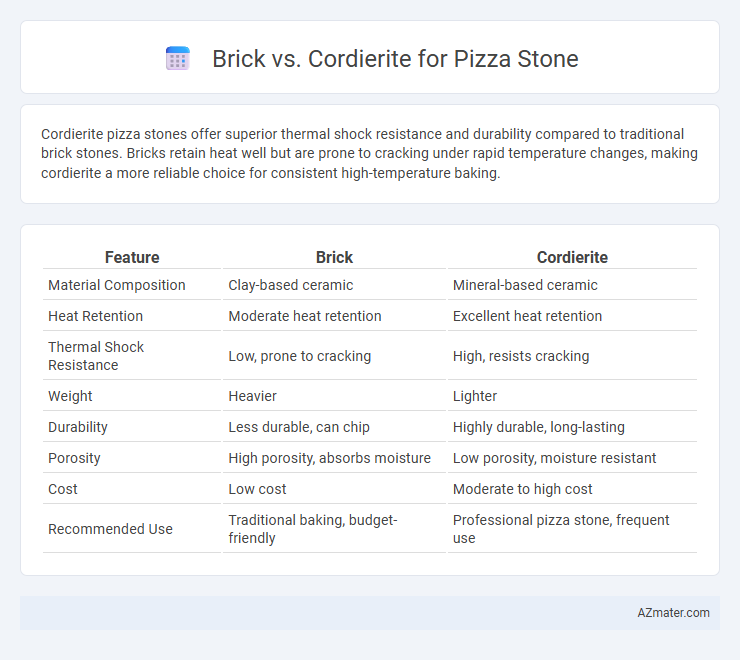Cordierite pizza stones offer superior thermal shock resistance and durability compared to traditional brick stones. Bricks retain heat well but are prone to cracking under rapid temperature changes, making cordierite a more reliable choice for consistent high-temperature baking.
Table of Comparison
| Feature | Brick | Cordierite |
|---|---|---|
| Material Composition | Clay-based ceramic | Mineral-based ceramic |
| Heat Retention | Moderate heat retention | Excellent heat retention |
| Thermal Shock Resistance | Low, prone to cracking | High, resists cracking |
| Weight | Heavier | Lighter |
| Durability | Less durable, can chip | Highly durable, long-lasting |
| Porosity | High porosity, absorbs moisture | Low porosity, moisture resistant |
| Cost | Low cost | Moderate to high cost |
| Recommended Use | Traditional baking, budget-friendly | Professional pizza stone, frequent use |
Introduction: Comparing Brick and Cordierite Pizza Stones
Brick pizza stones offer excellent heat retention and a natural porous surface that absorbs moisture, producing a crisp, evenly baked crust. Cordierite pizza stones provide superior thermal shock resistance and durability, making them less prone to cracking under rapid temperature changes. Choosing between brick and cordierite depends on durability needs, heat distribution preferences, and desired cooking results for homemade pizzas.
Material Properties: Brick vs Cordierite
Cordierite pizza stones offer superior thermal shock resistance and even heat distribution due to their strong, dense crystalline structure, preventing cracking during rapid temperature changes. Brick stones, made primarily from clay, provide excellent heat retention but are more porous, leading to uneven heat transfer and a higher risk of breakage under thermal stress. Cordierite's low thermal expansion coefficient makes it the preferred material for consistent, long-lasting pizza stones compared to traditional brick options.
Heat Retention and Distribution
Brick pizza stones offer exceptional heat retention due to their dense composition, maintaining high temperatures longer for consistent baking results. Cordierite stones excel in even heat distribution, minimizing hot spots and providing a uniform cooking surface that prevents burning. Both materials withstand thermal shock well, but cordierite's superior durability makes it ideal for frequent temperature changes in pizza ovens.
Durability and Longevity
Cordierite pizza stones surpass traditional brick in durability due to their excellent thermal shock resistance, allowing them to withstand rapid temperature changes without cracking. Brick stones, while effective in heat retention, are more prone to fractures and require more careful handling to prevent damage over time. Cordierite's longevity makes it a preferred choice for frequent pizza baking, offering consistent performance and reduced risk of breakage.
Cooking Performance and Crust Results
Brick pizza stones absorb and retain heat evenly, providing a consistent cooking temperature that promotes a crispy, well-baked crust with characteristic charring. Cordierite stones offer superior thermal shock resistance, allowing rapid heating and cooling, which enhances crust texture by preventing hot spots and reducing the risk of cracking. Both materials excel in delivering a crust with balanced crunch and moisture retention, but cordierite's durability makes it ideal for frequent high-temperature cooking.
Preheating Time and Temperature Tolerance
Brick pizza stones typically have shorter preheating times, reaching optimal cooking temperature within 30-45 minutes due to their dense structure and high thermal conductivity. Cordierite stones tolerate higher temperatures up to 1470degF (800degC) without cracking, making them ideal for intense heat baking. While cordierite requires longer preheating around 45-60 minutes to evenly distribute heat, its superior thermal shock resistance ensures durability under rapid temperature changes.
Maintenance and Cleaning Requirements
Brick pizza stones require regular seasoning and careful cleaning to prevent cracking and odor retention, often needing a gentle brush and avoidance of soap to maintain their porous surface. Cordierite pizza stones are more resistant to thermal shock and less porous, making them easier to clean with simple wiping or rinsing, and they do not require seasoning. For maintenance, cordierite stones generally offer longer durability and lower upkeep compared to brick, which demands attentive care to extend its lifespan.
Price and Accessibility
Brick pizza stones are generally more affordable and widely accessible, making them a popular choice for budget-conscious cooks and beginners. Cordierite stones, though pricier, offer superior durability and heat retention, resulting in better baking performance but are less commonly found in local stores. Online retailers often provide a broader selection of cordierite options, though at a higher investment compared to traditional brick stones.
Safety Considerations
Brick pizza stones, typically made from natural clay or firebrick, offer excellent heat retention but may contain trace impurities that could affect food safety if not properly sealed. Cordierite stones are favored for their non-toxic composition and superior thermal shock resistance, minimizing risks of cracking and contamination from stone particles. Both materials require thorough seasoning and regular cleaning to ensure safe, hygienic cooking surfaces for pizza preparation.
Which is Better: Brick or Cordierite Pizza Stone?
Cordierite pizza stones outperform traditional brick in heat retention and thermal shock resistance, providing consistent, high-temperature baking without cracking under rapid temperature changes. Brick pizza stones, while offering excellent heat holding capability, tend to absorb moisture and can be heavier and more fragile compared to cordierite. For durability, even heat distribution, and ease of maintenance, cordierite is the preferred material for an optimal pizza baking experience.

Infographic: Brick vs Cordierite for Pizza Stone
 azmater.com
azmater.com